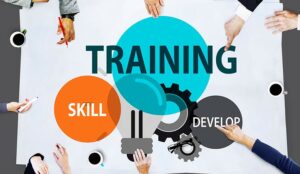Training can often be put on the back burner when there are staff shortages, which can be hugely detrimental, but there are some creative ways you can do things differently to make time for it.
This article outlines practical methods contact centre leaders can use to keep on top of training in a short-staffed contact centre.
How to Fit More Training into a Busy Day
Stop putting your agents’ training needs on hold when you’re short-staffed and start doing things differently instead.
Here are 17 time-savvy ways to keep on top of training in a short-staffed contact centre, to help with sustaining your contact centre training and coaching:
1. Think About What Your Team Actually Needs to Know
You need to think about what you need to train people on. If you have a new client and the agents need to know how to handle the contacts for that client, you’d traditionally want to hold a training session.
This would introduce the client, the types of expected contacts, the products and how to handle the contacts right down to the salutations to use.
Typically, these sessions may last an hour or half a day, which is a lot of time to take agents away from the floor.
Alternatives for this type of scenario could be:
What Do They Actually Need to Know About the Client?
- Can you run an awareness campaign with posters, quizzes, or a video?
What Do They Need to Know About the Contacts?
- Is the way they handle these contacts drastically different from the other clients? If it isn’t, then they only need to know about the differences.
- Would job aids work? Screen reminders or call-flows? Something agents can use at the ‘point of need’ rather than having to remember everything?
What Do They Need to Know About the Products?
- Can a desktop guide be created which can be used during the contact?
- Can your computer system have additional information or scripting included to assist the agents?
- Would it help to have an open SME chat, like a technical assistance line, which the agents can use during contacts?
You may have looked at these ideas and thought, “well, training would just be quicker and easier to get everyone done at once”.
Yes, it would get everyone trained, and they may go away with a workbook or aids to use on the contacts, but is this the best approach for your agents to give the best customer experience possible?
The next time you are short-staffed or the lines are busy, rather than scrapping the planned training, consider how else agents can get trained without being trained!
Contributed by: Kim Ellis, Chief Learning Architect at GO GINGER learning solutions
2. Try ‘Confidence on the Job’ Training

Boost everyday on-the-job skills by using confidence-boosting methods with team members.
Firstly, be absolutely immersed in the tasks of every individual, know what they are busy with. Secondly, ask for feedback and, lastly, celebrate the wins and learn from the losses.
It could sound like this:
- “Hey, what are you up to today?”
- “That sounds amazing, I’d love to hear how it goes. When could you have feedback ready?”
- “Amazing! What did you learn from the experience, what worked, and what do you feel could be improved?”
Using this method maintains high levels of performance, while ridding the team members of any complacency. Best of all, it only takes a few minutes.
3. Focus on One Topic at a Time
Training does not have to take up half a day or have cake and biscuits (although the latter is always welcome).
Training can be very effective in small doses, especially when it involves current challenges or situations. Focus on one topic at a time, track progress through on-the-floor feedback, and celebrate victories or learn from setbacks.
Contributed by: Clayton Drotsky, Director at Growth Crew Ltd
4. Create a Mentorship Programme

Establishing a mentorship programme in your contact centre can provide ongoing coaching and support to allow agents to continue developing their skills and knowledge. It can also encourage cross-training.
It also allows agents to have a broader understanding of the contact centre’s operations, leading to increased collaboration and a more cohesive team.
Contributed by: Stacy Sherman, Podcast Founder / Host of DoingCXRight
5. Offer Overtime to Fit in Training
Training before shifts and after shifts – and offering overtime – is another way to squeeze it in.
However, this should be done sparingly, as your team then face potential burnout if it becomes the norm.
6. Call on Other Departments for Temporary Relief
We often look to our own team when we have a demand problem, but it doesn’t hurt to look outwards to your colleagues for support.
Really think about the demand you have and who can help. For example, are there other departments that you can call on for temporary relief? Are there recent leavers that can support for periods where training is needed and can they be dual-skilled?
When we stop and think about ALL the possibilities, we can start to get more creative about the options.
Contributed by: Garry Gormley, Founder, CEO – FAB Outsourced Solutions
Want to find out more about utilizing support from other departments? Take a look at this article: Using Scheduling Playbooks to Manage Spikes in Service Demand
7. Ask Your Agents to Share Their Top Tips
You have super-skilled people in your team who all have their favourite techniques for doing their job well. Why not reach out to the whole organization and ask them to share their ‘Top Tip’ for creating a great customer experience and then publicize the best tip – weekly?
Those who have their tip featured could win a small prize and perhaps feature on the ‘top tip wall of fame’. Actions of this kind encourage participants from more and more of the team.
This type of activity is fun and engaging, but also genuinely supports upskilling and teambuilding in a low-effort, high-impact way.
8. Have a Group Discussion About a Real Call

Sometimes known as ‘calibration sessions’, these are simply a group learning environment in which attendees review a great and/or poor customer interaction and discuss what made it great/poor.
Sessions like this enable training from real examples, meaning they are relevant, easy to relate to and impactful, and whilst they require some ‘downtime’ for attendees, they require little effort to set up and coordinate.
9. Make It Part of Your Quality Assurance
Quality Assurance features heavily in every contact centre. We work hard to make sure every T is crossed and I is dotted with rigorous interaction reviews.
Good practice dictates that following on from the QA review, there should come a conversation with the agent about what they are doing well and where they can improve (coaching).
Very few Quality Assurance departments incorporate Experience Assurance in their QA review, where they not only check to ensure they do what they set out to, but that they also deliver the experience they intended.
By incorporating Experience Assurance into Quality Assurance, you can optimize time spent on reviews, whilst also opening an extra avenue for customer experience-focused, targeted coaching within an existing practice.
Contributed by: Katie Stabler, Founder and Director of Customer Experience at CULTIVATE
10. Virtual Options Keep Skills Sharp in Challenging Times

The situation on the front lines often makes pulling staff away for training less than appealing. Fortunately, online content delivery has evolved in such a way as to allow for a new generation of online learning that is both comprehensive and interactive.
Ideally, online learning for your team is balanced with ongoing, in-person training as well. But during challenging times, when formal training often takes a back seat, virtual options are a great strategy to help ensure that your team’s skills and service delivery stay sharp.
Contributed by: David Avrin, Customer Experience Keynote Speaker and Consultant at The Customer Experience Advantage
11. Set Up a Self-Paced “Learning Station”
If you are training on a physical product – and your agents are onsite – you can set up a self-paced “Learning Station” to help make time for training in a short staffed contact centre. This is a kiosk where agents on the contact centre floor can view the product and learn more about it.
After that, agents fill out a quick knowledge quiz to ensure they retain key details. Agents can visit the kiosk during a break (if that is allowed under your labour guidelines), or be scheduled to use the kiosk during a slower time.
For remote agents, a virtual tour of the product, followed by a quiz, may offer the same training benefits.
12. Smaller Training Groups Take Some of the Pressure off the WFM Team

To provide more scheduling flexibility for your Workforce Management (WFM) team, try breaking up larger classes into smaller groups.
In other words, instead of pulling 10 people offline at once for a training session, run two groups of 5 people instead, at different times.
While that means more work for the trainer in doing twice as many sessions, your WFM team may find it easier to schedule 5 people offline than 10 at once.
13. Take Advantage of Your Learning Management System (LMS)
Take advantage of your Learning Management System (LMS) to deliver very brief (5-minute) bursts of microlearning. This could consist of a quick video of a product, service, or process, followed by an eLearning quiz.
Since they are only 5 minutes long, microlearning bursts can be done even during busy times. They can be scheduled at a shift start, or during any slower times of the day or week.
Another advantage of microlearning is flexibility. Since it is self-paced, agents can be scheduled individually versus having to schedule 10–15 people offline at once for a formal training session.
Contributed by: Mike Aoki, President of Reflective Keynotes Inc.
14. Extend Lunch Breaks to Fit in a Bit of Training
Extending lunch breaks by 15 minutes for a micro-training session can be very effective.
Small bites are more easily digested.
Contributed by: Roy Atkinson, CEO at Clifton Butterfield, LLC
15. Just 90-Minute Sessions Every Month Can Get Results

I have a wonderful client that thought they could not take agents off the phone because of call volumes.
We broke up training into cohorts for just 90-minute sessions every month. The result of this consistent training was a higher NPS and higher Employee Satisfaction results.
Contributed by: Sangeeta Bhatnagar, SB Global Human Capital Solutions
16. An e-Learning Programme Gives Agents Autonomy

An e-Learning program allows staff to access training tools at any time, from anywhere.
When new agents are onboarded, they receive a login to this platform, where they can complete their training courses in a self-sufficient environment.
We have trainers available to assist at any time, but agents are given autonomy to complete their training at their own pace, and we’re able to track progress and set timelines.
Agents can also view their Training Plan through the dashboard, and appreciate having a space where they can keep their professional lives organized.
Contributed by: Neal Topf, President of Callzilla
17. Utilize Gamification Techniques
Make training more enjoyable and effective by incorporating rewards and recognition into learning programmes with gamification techniques.
Contributed by: Stacy Sherman, Podcast Founder / Host of DoingCXRight
Click here to discover 12 Reasons Why You Shouldn’t Skip Training in a Short-Staffed Call Centre
Reset Your Approach to Training
Another way to make time for training and coaching in a short-staffed contact centre is to look inwards.
Here are some thoughts on how changes to your management style, approach to training, and general priorities can create more tangible time for training – to everyone’s benefit.
Break the Habit of Learned Helplessness
With so many spinning plates for everyone within the contact centre, it’s very easy to get stuck in a learned helplessness, where we all just carry on trying to do everything because that’s just the way it is.
However, if you are able to give yourself time to escape, time just for you, away from your team and the floor, even if it’s only for 30 minutes, it will be beneficial in the long run. You can use this time to look at your team and the tasks that need doing.
Do this often enough and you’ll find efficiencies, you’ll identify what is a priority. When you are able to get your team’s tasks streamlined, you’ll find time for training!
Contributed by: Clayton Drotsky, Director at Growth Crew Ltd
Reimagine Training as Customer CARE Education

Don’t offer contact centre training. Training is finite, usually only one to several days. Training is top-down, one-way “I know everything, you know nothing” instruction. Training is the how and what of service.
The mission is to TAKE CARE of the customer. So instead, have customer CARE education. Don’t have trainers or instructors. Have mentors and coaches. Your education is interactive and frequent. Your education is the how, what, and, why of service excellence.
As mentors, educate your associates with role-playing customer CARE (Communicate, Acknowledge, Respond, Enrich) actions to practise their soft skills. Your associates will learn and appreciate the value of telephone etiquette, forbidden phrases, service recovery, and customer care.
With suggestions, recommendations, and encouragement, empower your people to develop THEMSELVES. Your people will be enthused and energized to engage customers.
Contributed by: Bill Quiseng, Chief Experience Officer at billquiseng.com
Stop Mistaking the Urgent for the Important, or the Important for the Critical

Many companies have developed micro-training modules, decreasing the demand for long periods of dedicated training time. But the time for utilizing micro-training still must be protected!
Self-paced learning can be defeated by distraction and interruption. Essentially, this means that senior leaders have to commit to the time allotments and not fall prey to “bumping” training.
So-called “buy-in” is not enough; there has to be commitment, and part of that commitment is not mistaking the urgent for the important or the important for the critical.
Ground rules for the training periods have to be set and not broken unless there is a critical need, and what is “critical” needs to be clearly defined in advance.
Contributed by: Roy Atkinson, CEO at Clifton Butterfield, LLC
Always Ask Yourself if Training Really Is the Answer

‘We need training on XX’ is something I heard many times when I worked as a trainer in the contact centre. So before you say this to your training team, consider: is training the answer?
Training is time-consuming to build and it’s time-consuming for people to complete. Often when the lines get busy, training is the first thing to be put on hold.
So instead of considering training as being the first option, think about other activities which can be done. For instance, if you need the AHT to reduce by 5 seconds per call, look at what procedures can be streamlined, or if the software you are using is performing at optimal levels.
When training is needed, rather than thinking about taking agents away for a course, look at ‘point of need’ training, resources which can be quickly accessed by agents when they are needed. Or even an email campaign which gives agents a scenario or problem to solve and can be done between contacts.
Contributed by: Kim Ellis, Chief Learning Architect at GO GINGER learning solutions
Review Your Shrinkage Plan

Go back to the fundamentals and look at your resource plan! Are you pulling the training because you are busy, or are you pulling it because you are generally under-resourced?
In which case, are you solving for the right problem? Working collaboratively with training, the ops team, and planning to work out what needs to happen will help you think outside the box.
Review your shrinkage plan! What percentage are you actually building in for training and is this enough? Can you manipulate your shrinkage in other areas that means you don’t sacrifice training activities?
Contributed by: Garry Gormley, Founder, CEO – FAB Outsourced Solutions
Looking for some more training ideas? Then read these articles next:
- 9 Fun Customer Service Training Exercises
- How to Design a Call Centre Training Programme
- 16 Customer Service Training Ideas – With Activities, Games and Helpful Techniques
Author: Megan Jones
Reviewed by: Jo Robinson
Published On: 10th Apr 2023 - Last modified: 24th Sep 2025
Read more about - Call Centre Management, Bill Quiseng, Clayton Drotsky, David Avrin, Garry Gormley, Katie Stabler, Kim Ellis, Management Strategies, Mike Aoki, Neal Topf, Roy Atkinson, Sangeeta Bhatnagar, Stacy Sherman, Staffing, Training and Coaching





































